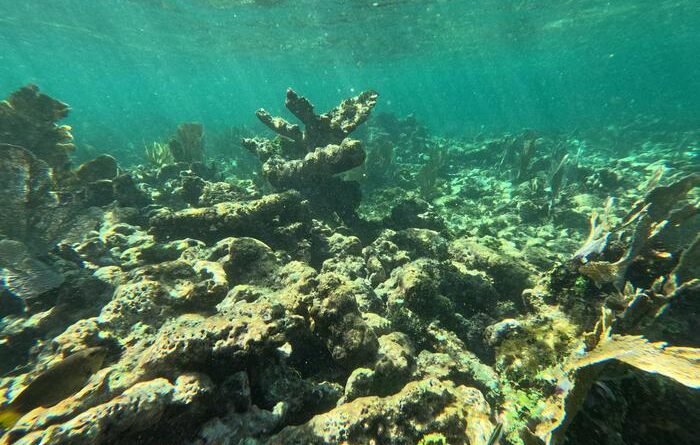Over 70% of Western Atlantic Coral Reefs Will Stop Growing by 2040
- To understand how changes in reef ecology affect their growth, researchers analyzed fossil reefs from the tropical western Atlantic. This gave them a better insight into how growth rates vary depending on coral species.
- They then combined these findings with ecological data from more than 400 modern reefs in the region to calculate current growth rates and to predict whether reefs will be able to keep up with future sea-level rise under different climate scenarios.
- Analysis of 429 sites in the tropical western Atlantic shows that most coral reefs are currently unable to keep pace with historical sea level rise (1993–2010), and projections to 2040 under even the lowest emission scenario (SSP1–1.9) suggest that almost all reefs will fall behind rising sea levels.
- The results, published in the journal Nature, predict that by 2040, more than 70% of reefs will have stopped growing, and over 99% will do so by 2100 if global warming exceeds 2°C.
Coral reefs in the tropical western Atlantic could become a thing of the past, according to research by an international team led by the University of Exeter. The team analyzed more than 400 reef sites around Florida, Mexico, and Bonaire. Their results, published in the journal Nature, predict that by 2040, more than 70% of reefs will have stopped growing, and over 99% will do so by 2100 if global warming exceeds 2°C.
The study, with Professor Chris Perry of the University of Exeter as the corresponding author, was published in September under the title ‘Reduced Atlantic reef growth past 2 °C warming amplifies sea-level impacts.’
“The present major challenge is that most of the biggest drivers of ecological change -and specifically at a global scale, here we can think about thermal stress and bleaching, and in places like the Caribbean, coral diseases – impact coral populations regardless of whether they are in or outside a marine protected area. Effective marine protection probably can help to at least create conditions under which recovery might occur, but the bigger issue is climate warming and the increasing frequency and intensity of resultant thermal stress events – this is essentially impossible to manage locally,” said Professor Perry.
Rising seas increase the risk of flooding and threaten coastal habitats. “Globally, reef-derived coastal protection functions benefit an estimated 5.3 million people and protect coastal assets valued at around US$109 billion per decade,” the study notes. Additional factors, such as ocean acidification and coral disease, further slow reef growth.
What did a typical day of your research look like, and during sampling, what did you find most enjoyable and most challenging?
Professor Perry: Research and fieldwork are always enjoyable – even when tough going – not least because you are always seeing new things and learning more. There is really no typical research field day, but these normally involve getting out early and working in the field until early afternoon – there is then the usual gear strip down and cleaning and prep for the next day, and then usually time in front of a screen doing data entry or in the lab doing sample processing. The most challenging aspects arise from where we work – marine fieldwork is always challenging by its very nature, but our interests focus especially on the very shallow reef environments where wave action is at its highest – this can make for very challenging working conditions.
The study
For coral reefs to continue protecting the coast, their growth must keep pace with rising sea levels. If reef growth lags, the water above them becomes deeper, allowing more wave energy to cross reef surfaces, which increases coastal flooding risk. The maximum vertical growth of a reef -so-called maximum accretion potential– depends on how much calcium carbonate (CaCO₃) the corals produce and how much is lost to erosion.
Analysis of fossil reef images in the tropical western Atlantic showed that the average framework (stacking) porosity is only 38.3 ± 10.1%, significantly lower than the previously assumed 50–70% for Indo-Pacific reefs. As Professor Perry explained, low framework porosity means lower reef growth, and high porosity means higher reef growth. The revised lower porosity values mean that overall growth estimates are lower, but they are much lower for the branching coral assemblages, which drive the highest reef growth (and create more porous frameworks). The study only considered the overall framework (stacking) porosity – the proportion of empty space within the reef framework – rather than the porosity of individual coral skeletons.
This provides a useful baseline for comparison with modern reefs.
“Using these revised lower porosity values reduces accretion estimates, highlighting the need to re-evaluate contemporary reef growth estimates to more reliably predict the effects of current and future sea level rise,” the study states. In other words, modern growth rates must be reassessed to better understand and predict the impact of sea level rise.
The researchers then analyzed the three largest existing databases of reef carbonate budgets in the tropical western Atlantic. The carbonate budget is important because it shows how much calcium carbonate corals produce compared to how much is lost. This balance indicates how fast a reef can grow and whether it can keep up with rising seas. The researchers analyzed data collected between 2016 and 2022 from 429 locations: Florida Keys (113), the Mesoamerican Reef and Gulf of Mexico (88), and Bonaire (228)
Reef growth rates were compared to historical sea level rise and then projected for 2040, 2060, and 2100 under four climate scenarios (SSP1–2.6, SSP2–4.5, SSP3–7.0, and SSP5–8.5). SSPs are scenarios developed by the IPCC to describe different greenhouse gas emission trajectories and levels of global warming. These projections help assess whether reefs can keep up with sea level rise.
Almost all reefs will be unable to keep up with the expected sea level rise
Example: The data consist of maximum reef growth rates measured at 429 modern reef sites in the tropical western Atlantic (TWA), which were compared with historical sea level rise (1993–2010) and projected rise to 2040 under the SSP1–1.9 scenario. The results show that no sites in Florida, and only a small percentage in Mexico (5.5%) and Bonaire (5.7%), currently have growth rates exceeding historical sea level rise. Compared to the projected rise to 2040 under the SSP1–1.9 scenario, the situation is even more concerning: almost all reefs will be unable to keep up with the expected sea level rise.
As for sea level rise, by 2040, more than 70% of tropical western Atlantic reefs will have stopped growing. By 2060, water depth is expected to increase by 0.3–0.5 m above current levels. By 2100, in scenarios with warming above 2 °C, the depth increase could reach 0.7–1.2 m, resulting in a greater risk of flooding and changes to coastal ecosystems and currents. Even under the optimistic SSP1–2.6 scenario, in which global warming remains below 2 °C by 2100, the average water depth above reefs in the TWA region is projected to increase to about 0.5 m (Florida 0.48 m; Mexico 0.52 m; Bonaire 0.41 m). In other words, increasing water depths will limit the capacity of reefs to protect coastlines from wave energy.
It is predicted that TWA coral reefs will not be able to sufficiently reduce the effects of sea level rise under future climate scenarios. Reef restoration through coral planting can partially increase growth rates and mitigate these effects, but it requires a high percentage of coral cover and intensive effort. For this reason, in addition to local restoration, global action to limit warming below 2 °C is crucial to protect coasts and ecosystems.
How much attention is really paid to scientific findings when it comes to policymaking? And what would you like your study to change?
Professor Perry: I think my impression is that uptake in policymaking is variable. I don’t work in the political or policymaking space, but in many areas, there is clearly a desire and strong drive for action, and things are happening. However, at present, this is facing considerable pushback from some political quarters, and globally, we are in challenging economic times. Meaningful action to reduce carbon emissions needs political will and public support – and will not be cheap, of course. There is probably also a major hurdle here because positive changes, e.g., on atmospheric greenhouse gas levels, are going to take time to come to fruition – even if we do a lot now. However, the social and economic costs of not acting are going to be vast, affecting everyone globally, and this is what needs to be made clearer.
In terms of this new study, I think it makes a compelling case for regional-scale impacts on major marine ecosystems if we do not act. It also adds to the growing body of evidence of impacts that will occur across all marine and terrestrial ecosystems.
The study highlights that western Atlantic coral reefs are losing their ability to keep pace with rising sea levels, even under the lowest emission scenarios. While fossil evidence provides a baseline for understanding reef growth, today’s reefs face compounding pressures. Without rapid global action to reduce warming and protect reef systems, these vital ecosystems – and the coastal protection they provide – could largely disappear.
Image Credit: Chris Perry/Dead reef crest on Mexico’s Caribbean coast


